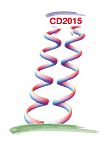Speaker
Johann Haidenbauer
(IKP, Forschungszentrum Juelich)
Description
We present results for the in-medium properties of a hyperon-nucleon (Y N) interaction derived within chiral effective field theory (EFT) and fitted to ΛN and ΣN scattering data. The single-particle potentials for the Λ and Σ hyperons in nuclear matter are evaluated in a conventional G-matrix calculation, and the Scheerbaum factor associated with the hyperon-nucleus spin-orbit interaction is computed [1]. We consider a leading-order (LO) Y N interaction published in 2006 which accounts well for the bulk properties of the ΛN and ΣN system [2], and our recent Y N potential derived up to next-to-leading order (NLO) in chiral EFT which provides an excellent description of the available low-energy ΛN and ΣN cross sections and the inelastic capture ratio at rest [3]. The predictions for the Λ single-particle potential are found to be in good qualitative agreement with the empirical values inferred from hypernuclear data. A depth of about −25 MeV is predicted by the NLO interaction and of about −36 MeV by the LO potential. The Σ-nuclear potential turns out to be repulsive, in agreement with phenomenological information, with values around 15–20 MeV. Empirical information suggests that the Λ-nucleus spin-orbit interaction should be rather weak. Therefore, we investigate also the spin-orbit interaction and, in particular, the role of the antisymmetric spin-orbit force in the Y N system. The chiral EFT approach yields a potential that contains, besides pseudoscalar meson exchanges (π, K, η), a series of contact interactions with an increasing number of derivatives. In this approach a contact term representing an antisymmetric spin-orbit force arises already at NLO. It induces 1P1–3 P1 transitions in the coupled (I = 1/2) ΛN–ΣN system. The low-energy constant associated with the contact term could not be pinned down by a fit to the existing ΛN and ΣN scattering data as found in Ref. [3] and, thus, it was simply put to zero in that work. However, it turns out that its value can be fixed from investigating the properties of the Λ hyperon in nuclear matter and, specifically, it can be utilized to achieve a weak Λ-nuclear spin-orbit potential [1].
References
1. J. Haidenbauer and U.-G. Meißner, Nucl. Phys. A 936, 29 (2015).
2. H. Polinder, J. Haidenbauer, and U.-G. Meißner, Nucl. Phys. A 779, 244 (2006).
3. J. Haidenbauer, S. Petschauer, N. Kaiser, U.-G. Meißner, A. Nogga, and W. Weise, Nucl. Phys. A 915, 24 (2013).
Primary author
Johann Haidenbauer
(IKP, Forschungszentrum Juelich)

